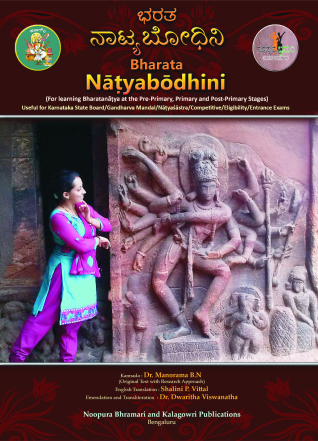The Vijayanagara Empire witnessed the rule of mighty leaders whose capable administration propelled the province to global glory. People from all over the world engaged in trade within this empire, and renowned scholars contributed their wisdom, making it not only economically prosperous but also culturally rich. Different genres of literature like kāvya, nāṭaka, itihāsa, purāṇa, dāsa sāhitya, jaina sāhitya, were written and popularized under the patronage of Vijayanagar kings. Krishnadevaraya authored numerous literary works, displaying a genius that allowed him to resonate with the contemporary mindset of his readers, audience, or spectators. Among his works, Āmuktamālyada and Jambavati Pariṇayam have been published and are available, while Madālasacaritam and Satyavadhū Pariṇayam remain unavailable.
This eight pages lengthy article examines about the content of King Krishnadevaraya's literary contributions and also gives a path to understand and appreciate his works with an eye towards social values of that time.
by
Nagaranjitha Sidramaya
: Category :
Research articles
: 19 Oct 2023 Issue No.: 2 Volume No.: 17
Parakiya is the type of nayika who does not belong to the nayaka. Infidelity by a lady towards her man was considered as one of the pancamahapapam-s yet today she is considered as the highest form of devotion.
Lets closely examine the nayika of this special genre in the research article title 'An in-detail analysis on Parakīyā nāyikā'
by
Dr Dwaritha Viswanatha
: Category :
Research articles
: 30 Nov 2018 Issue No.: 4-6 Volume No.: 12
Karnāṭaka Music has various musical genres and the most interesting among them is rāgamālika-s. The contribution of prominent composers like Muddusvāmy Dīkṣitar, Svāti Tirunāḷ, Tiruvoṛṛiyūr Tyāgayyar, and Harikēśanallūr Muttiah Bhāgavatar in the realm of rāgamālika is well known. What is lesser known is the contribution made by the members of the family of Muddusvāmy Dīkṣitar, namely Rāmasvāmi and Subbarāma Dikṣitar. Subbarāma Dikṣitar, well known for his text Saṅgīta Sampradāya Pradarśini has composed ten rāgamālika-s, including a rāgāṅga rāgamālika. The rāga-s featured in his rāgamālika-s range from a common ones like Kalyāṅī, Śaṅkarābharaṇa to rarer ones like Rudrapriyā and Balahaṃsa. Since three members of this family have handled this musical form, this article attempts to know whether any similarities exist between the compositions of Subbarāma Dikṣitar with his predecessors. Also, we will be engaging ourselves to know the system followed by in handling the rāga-s which got its svarūpa changed, predominantly in the last century.
by
DrAravindhanTR
: Category :
Research articles
: 01 Aug 2021 Issue No.: 2 Volume No.: 15
It is a brief study of both traditions in their presentation of mythological stories.This study, is based mainly on the knowledge and guidance given by the great scholar Shatavadhani Dr R. Ganesh who has been passionately refining and promoting the art of Yakshagana in Karnataka.
by
veena murthyvijay
: Category :
Research articles
: 22 Mar 2019 Issue No.: 1 Volume No.: 13
ನಾಟಕಗಳಪ್ರಯೋಗಗಳಲ್ಲಿ ಬಳಸಿಕೊಳ್ಳುವ ಉದ್ದೇಶದಿಂದಲೇ ರಚಿತವಾದ ಹಾಡುಗಳನ್ನು ರಂಗಗೀತೆಗಳು ಎಂದು ಸರಳವಾಗಿ ಅರ್ಥೈಸಿಕೊಳ್ಳಬಹುದಾಗಿದೆ.
ಮೂಲನಾಟಕದ ಕೃತಿಯೊಂದರಲ್ಲಿ ಹಾಡುಗಳೇ ಇಲ್ಲದಿದ್ದಾಗ ನಿರ್ದೇಶಕನು ನಾಟಕ ಒಂದರ ಪ್ರಯೋಗದಲ್ಲಿ ಹೆಚ್ಚಿನ ಪರಿಣಾಮವನ್ನು ನೀಡುವ ಉದ್ದೇಶದಿಂದ ಆಯಾ ಸಂದರ್ಭಗಳಿಗೆ ಔಚಿತ್ಯಪೂರ್ಣವಾಗಿ ಹೊಂದುವ ಇತರೆ ಯಾವುದೇ ಹಾಡು, ಗೀತೆ, ಕೀರ್ತನೆ, ಕೃತಿ, ಭಾವಗೀತೆ, ವಚನಸಾಹಿತ್ಯ, ಶ್ಲೋಕ, ದೇವರನಾಮ, ಜಾನಪದಗೀತೆ, ತತ್ವಪದ, ಹಳೆಗನ್ನಡ ಕಾವ್ಯದ ಹಾಗೂ ವೇದ ಉಪನಿಷತ್ತುಗಳ ತುಣುಕು, ಪಾಶ್ಚಿಮಾತ್ಯ ಸಂಗೀತ, ಮೊದಲಾದ ಪ್ರಕಾರಗಳನ್ನು ಬಳಸಿಕೊಳ್ಳುವ ಪರಿಪಾಠವಿದೆ. ಆದರೆ ಇವುಗಳನ್ನೂ ರಂಗಗೀತೆಗಳೆಂದು ಅರ್ಥೈಸುವುದು ಸರಿಯಾದ ಕ್ರಮವಲ್ಲ.


